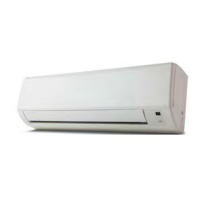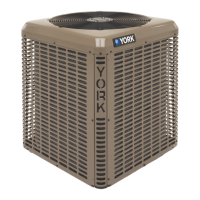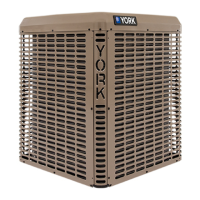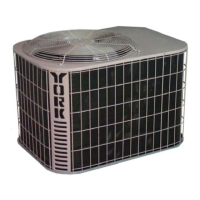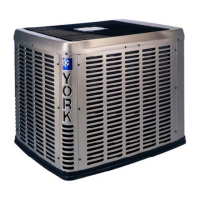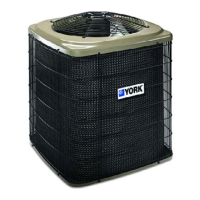5390862-UIM-A-0318
8 Johnson Controls Unitary Products
SYSTEM CHARGING
The factory charge in the outdoor unit includes enough charge for the
unit, a 15 ft. (4.6 m) line set, and the smallest indoor coil match-up.
Some indoor coil matches may require additional charge. See tabular
data sheet provided in unit literature packet for charge requirements.
The “TOTAL SYSTEM CHARGE” must be permanently stamped on the
unit data plate.
TOTAL SYSTEM CHARGE is determined as follows:
1. Determine the Base Charge shipped in the outdoor unit from the
Tabular Data Sheet included with the outdoor unit.
2. Determine the charge adder for the matched indoor unit from the
Tabular Data Sheet included with the outdoor unit.
3. If the lineset length is greater than 15 feet (4.6 m), calculate the
charge adder for actual lineset length using the Tabular Data
Sheet included with the outdoor unit.
4. Once the charge adders for matched indoor unit and for lineset
have been weighed in, verify the system operation against the
temperatures and pressures in the Charging Chart for the outdoor
unit. Locate Charging Charts on the outdoor unit and also in the
Service Application Data on
www.upgnet.com. Follow the Subcool
or the Superheat charging procedure in the section below accord-
ing to the type of indoor metering device in the system, and allow
ten minutes after each charge adjustment for the system operation
to stabilize. Record the charge adjustment made to match the
Charging Chart.
5. Verify that TOTAL SYSTEM CHARGE = Base Charge (as
shipped) + charge adder for matched indoor unit + charge adder
for actual lineset length + charge adjustments to match Charging
Chart.
6. Permanently stamp the unit data plate with the TOTAL SYSTEM
CHARGE as defined above.
This method is to be used whenever additional refrigerant is required
for the system charge.
If a calibrated charging cylinder or accurate weighing device is avail-
able, add refrigerant accordingly. Otherwise, model-specific charging
charts are provided on the access panel of the unit.
SUBCOOLING CHARGING METHOD - TXV INDOOR
The outdoor unit comes equipped with subcooling charts optimized for
that particular unit. Please follow the instructions on the unit. If those
instructions are not readily available, follow the instructions below.
1. Set the system running in cooling mode by setting the thermostat
at least 6°F below the room temperature and operate system for at
least 10 – 15 minutes.
2. Refer to the technical guide for the recommended indoor airflow
and verify it is correct (it should be 350- 400 SCFM per ton).
3. Measure and record the indoor wet bulb (WB) and the outdoor
ambient dry bulb (DB) temperature.
4. Using the charging chart located on the unit, find the intersection
of the indoor wet bulb and the outdoor dry bulb. This is the recom-
mended liquid pressure (and subcooling value).
5. Measure and record the pressure at the liquid valve pressure port
and compare to the value obtained in step 4.
6. Add charge if the measured liquid pressure is lower than the rec-
ommended value. Remove / recover charge if the measured liquid
pressure is above the recommended value.
Condenser subcooling is obtained by calculating the difference of the
saturated refrigerant temperature of the pressure measured at the liquid
base valve and the liquid tube temperature as measured at the liquid
base valve.
Subcooling Temp. (TC) = Saturated Temp. (TS) – Liquid Temp. (T).
NOTICE
For cold weather charging of the system at temperatures of 55°F or
below, refer to the “Optional Cold Weather Charging” procedures
near the end of SECTION VI: SYSTEM CHARGE.
CAUTION
R-410A refrigerant cylinders are rose colored. Always charge the
system slowly with liquid R-410 refrigerant.
CAUTION
Do not leave the system open to the atmosphere.
WARNING
DO NOT attempt to pump “Total System Charge” into outdoor unit for
maintenance or service. This may cause damage to the compressor
and/or other components. Recover and weigh “System Charge” into
an appropriate recovery cylinder for any instances requiring evacua-
tion.
!
!
!
WARNING
It is recommended to not attempt to pump more than the “Factory
Charge” and an additional 15 foot line charge into a tube and fin out-
door unit for maintenance or service. This can cause damage to the
compressor and/or other components.
CAUTION
Refrigerant charging should only be carried out by a qualified air con-
ditioning contractor.
CAUTION
Compressor damage will occur if system is improperly charged. On
new system installations, charge system per tabular data sheet for
the matched coil and follow guidelines in this instruction.
Example: The liquid pressure listed at the intersection of the indoor
WB and the outdoor DB 320 psig. Pressure at the liquid valve is 305
psig. It would be necessary to add refrigerant to increase the liquid
pressure to 320 psig.
CAUTION
IT IS UNLAWFUL TO KNOWINGLY VENT, RELEASE OR DIS-
CHARGE REFRIGERANT INTO THE OPEN AIR DURING REPAIR,
SERVICE, MAINTENANCE OR THE FINAL DISPOSAL OF THIS
UNIT.
!
!
!
!
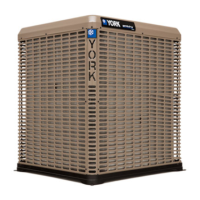
